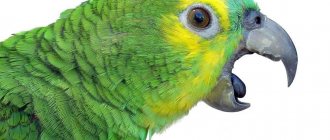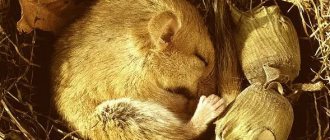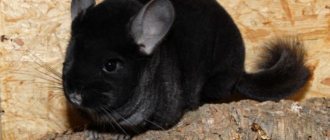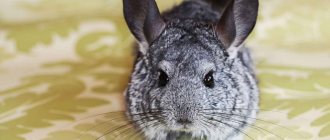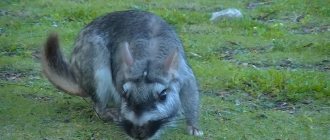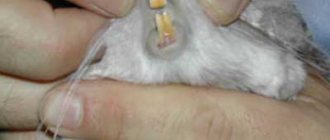- home
- Chinchilla
- Character and features
04/10/2019 Active animals communicate with their owners and brothers using many calls. If your pet screams or squeaks, this is a reason to pay attention to the signals. They will provide an opportunity to learn more about the pet and its relationships in the pack.
Why can a chinchilla squeak?
Males and females differ somewhat in their personalities and in the sounds they make.
During the mating season, the boy screams quietly, while he clears a place under him and slightly twitches his tail. So, the boyfriend makes it clear to the chosen one that he is ready to mate.
The female during estrus can behave differently. If a lady accepts courtship, then her sounds will be soft and inviting. In case of disagreement, she sharply snorts and squeaks. Moreover, notes of resentment are clearly visible in the voice. At the same time, the rejected gentleman may whine and squeal pitifully.
During the extramarriage season, the male is quite phlegmatic and peaceful. It rarely makes noise and does not require much attention. 30 minutes a day will be enough for your pet to behave calmly and quietly. The sounds that the boy makes are low screams, hissing, or hoarse, muffled quacking.
Girls, by their nature, are much more active, more aggressive, they need more attention. Also, females are more likely to show a desire to communicate.
Sounds made by females:
- Shout.
- Squeak (with many variations of intonation).
- Duck quack.
- Hiss.
- Grunting.
- Hooting.
- Grunting.
- Sound like a dog barking, etc.
Males also scream in a similar way, but in them it manifests itself less frequently and less intensely.
While an angry female will not only squeak, but bite and try to spray the “attacker” with urine.
Chinchilla voice library
Let us conditionally divide all the sounds of chinchillas according to directions and give examples of each of them. You can listen to these “conversations” of the animals in the appropriate section. Here you will find contact signals, calls for the opposite sex, expressions of dissatisfaction and love for children, other animals and many other sounds of chinchillas.
Sorry, there are no surveys available at this time.
These rodents are known to become more active at night, so don't be surprised if you hear strange squeaks or squeals, grunting of teeth, or anything else inarticulate. The pet makes an exclamation when it wants to convey something or simply feels a lack of attention. Let us further consider situations in which a chinchilla can make one or another sound at night and during the day.
Sounds during contact and communication
To communicate with each other, rodents use an exclamation similar to a grumbling speech. If you hear it, you can remain calm, since the pet is simply expressing closeness to other chinchillas or is simply suffering from loneliness and reports this to its “neighbors.” What sound is this? We invite you to listen.
Article on the topic: Where do chinchillas live in the wild: photographs of the animal, description of the habitat and lifestyle
Sounds of mating
Chinchillas who want or do not want to mate behave especially interestingly. As a rule, the male pursues the female, emitting an inviting squeak. This happens mainly when a girl goes into heat. But this is not at all a reason to agree to mating. In response, the girl may squeal irritably, splash urine in the male’s face and thereby express her protest.
Some boys turn out to be quite persistent and continue to get their way. At the same time, they can continue to invite a potential partner and throw their tail or make an offended sound after refusal.
Immediately after mating, the male utters hoarse exclamations, after which the partners peacefully fall asleep, sitting side by side on the same shelf or in the house.
Sounds of cubs
Next to their mother, little shins make loud squeaks, thereby telling them that their mother is nearby and they want to eat. In response, the nurse may grumble and lick her baby's ears. It also happens that children worry their mother by biting her nipples or starting a fight for milk. Then mom gets angry and her contented grumbling turns into an irritated scream.
In this video you can listen to a mother cooing with her children.
Sounds of protest and defense
It may be unclear why a chinchilla squeaks when sitting at the feeder or when next to its cage neighbor. Sometimes, with the help of protesting sounds, the rodent makes it clear that it has become a victim and has been infringed by another inhabitant of the cage. Each animal has its own character, and therefore some pets in a cage may be more assertive and capable of offending others.
The injured party will clearly make itself known with a nervous exclamation, similar to the tone in which a person says “Get out of here!”
Article on the topic: How many years do chinchillas live at home, average life expectancy in captivity
In some situations, a chinchilla emits a defense signal when it wants to protect itself from danger. Then the exclamation will be short and in intonation will also be similar to the human “Go away!” Often a rodent utters such an exclamation when a stranger picks it up or approaches the cage.
Sounds of Anger
When an animal is angry, it often stands on its hind legs and at the same time emits a characteristic loud cry. A chinchilla's anger may be accompanied by splashes of urine into the opponent's face. Mostly, a mother chinchilla can get angry with her babies, as well as a female with a male for being too persistent in courtship.
Alarm sounds
When a chinchilla is worried about something or is scared, it can make alarm calls to warn its relatives. These are short syllables coming in a simultaneous stream from a small mouth. In reality, this exclamation looks very funny and looks like a quiet short bark. That is why it is often called the chinchilla bark. Quite often, a pet makes similar alarming sounds in a new home. And when she gets used to the home, she will make such exclamations less and less often.
Chinchilla care
Daily care and maintenance of a chinchilla at home consists of the following steps:
- Cleaning the feeder and drinker. Then they are filled with fresh food and clean boiled water.
- Cleaning up fallen hay, replacing toilet filler in the tray.
- Sweeping debris from shelves, swings and ladders.
- Cleaning up trash in and around the cage.
Once a week you need to do the following:
- Wash the tray in the cage using detergents.
- Disinfect the drinking bowl.
- Change the sand in the bathhouse.
- Wipe the dust in the cage.
- Completely replace the contents of the bedding at the bottom of the cage.
What you need to keep a chinchilla
First of all, to keep a chinchilla you need a spacious cage in which the pet will spend most of its life.
- Buy a drinking bowl, preferably a hanging one, and a feeder. Place a mineral stone or tree branches in the cage, install a hanging container with hay;
- Equip your home with shelves, a wheel, stairs, a hammock and a house so that your pet can spend active leisure time;
- Do not let your chinchilla roam around the apartment on its own, otherwise it will chew wires and wallpaper. It is better to purchase a walking ball that is suitable in size.
Chinchilla is a nocturnal animal, and this is worth considering
Sounds and signals of chinchillas during mating season
Quiet and inviting sounds mean a male courting a female during estrus. This is how the partner says that he is ready to mate.
However, ladies do not always accept the advances of their gentleman, and snort sharply and angrily as a sign of protest. At the same time, the upset partner whines or squeals pitifully.
If the gentleman turned out to be persistent and the courtship ended successfully, the male hiccups briefly and hoarsely.
Normal noise while eating
Before buying any rodent, you need to remember that they eat quite noisily, especially at night, when there is absolute silence in the house. Chinchillas are very active at night, so after playing and running around they immediately want to eat.
Chinchillas make a very loud noise at night when:
- They chew their house and shelves
- They chew on wood and mineral stones
- Eating crackers and sweet sticks
After reading this article, I hope that it will be easier for you to distinguish the sounds that your pet makes and if he asks for help, then you will understand it. It is very important to recognize your chinchilla's requests so that its life is comfortable, as a result of which it will make less noise at night and disturb you.
Before buying a chinchilla, you need to remember that the chinchilla will live in a separate room from where the sound will not be heard, or you will have to get used to noisy nightlife. Of course, it is possible to train a chinchilla to sleep at night so that it makes less noise, and we have a separate article about this.
Shedding fur
Shedding fur should not be confused with the natural process of shedding.
A chinchilla should shed slowly and regularly. Therefore, if a chinchilla is completely bald, perhaps something has frightened it very much.
Rapid fur release is a defense mechanism used when a chinchilla feels trapped or threatened. Animals often use this in the wild, for example if a chinchilla is caught by a predator. But pet chinchillas can also shed fur if they are in a stressful situation.
Shedding fur is also a natural process and should not cause much concern to pet owners. If your hairless chinchilla is feeling normal, carefully inspect all exposed areas of his skin. You don't need to go to the vet or treat the bare skin area unless it starts to look painful.
Causes of screaming at night
Quite often there are situations when a person wakes up at night from the furious screams of his pet. At first glance, it may seem that something happened to them. However, chinchillas make sounds on harmless occasions. The most common reason is boredom. If your pet lacks attention or affection, then he can demand it in his own ways. Even the dead of night will not stop him in this.
If several animals live in a cage, then the reasons for screaming may be different:
- fight for food or toys;
- sharing a comfortable place;
- sensation of unpleasant odors and sounds;
- painful sensations.
Did you know? Chinchillas can sleep upside down. This is because in the wild they have to sleep in small cracks on the side of mountains.
Why does a chinchilla scream at night?
Most often, a chinchilla screams at night. This is due to the fact that wild habitats force animals to be nocturnal and hide during the day in rock crevices and burrows. Similar behavior is also typical for domestic animals. Similar to their wild counterparts, they are able to sleep all day in a cage or hide in a secluded corner, becoming mobile in the late afternoon.
At night, the pet arranges something like Armageddon in the cage, accompanied by fuss and frequent loud screams. Often, when a chinchilla screams at night, it forces owners to become frightened and find ways to deal with the situation. However, there is nothing to worry about, since the animal’s night cries have a logical and simple explanation.
At night the animal screams when:
- he is bored and requires the attention and communication of the owner;
- they forgot to treat him with a tasty treat on time, and he is indignant at this fact;
- Fluffy wants to frolic, and he asks to be released;
- noise or strange sounds frightened him and caused short and sharp screams;
- he was frightened by a cat that approached the cage at night. The sounds produced resemble a loud scream;
- several individuals started a fight over food or a toy;
- I had a bad or disturbing dream.
If sounds at night have no special reason, it means your pet is sick or in pain. In this case, the furry prankster must be taken to the veterinarian.
Rules for feeding pet chinchillas
The chinchilla is a herbivorous rodent that eats food in small quantities, but quite often.
Basic feeding rules:
There should always be a supply of healthy food in your pet's feeder. New foods are introduced into the diet with caution. Balanced and varied menu. Chinchillas are very active, so they need high-calorie food, which also keeps the rodent's beautiful fur healthy.
Nutrition and daily routine
Chinchillas are nocturnal. Activity appears closer to 18-20 pm. The owner must ensure that there is enough food in the pet's feeder to eat at night.
It is better to feed the rodent at the same time. He will quickly get used to the regime, which will have a positive effect on the digestion process.
Chinchillas have sharp teeth that grow throughout their lives. In order for the pet to have the opportunity to grind down its teeth if necessary, you need to put tree branches in the cage, with the exception of coniferous species with a high resin content. Preferred are apple, linden, birch and hazel.
In addition to wooden twigs, special toys, mineral and chalk stones are also used.
Composition and balance of the diet
The diet for a pet rodent is selected individually, taking into account the pet’s age, health status, taste preferences and physiological characteristics of the body.
The main composition of the diet for pet chinchillas:
- Rough feed - hay, branches of trees and shrubs.
- Grain mixtures for chinchillas.
- Treats – berries and nuts, dried fruits, vegetables.
The daily food intake for an adult pet is 55-65 g. A balanced diet involves feeding in the following ratio: 25 g of roughage, 25 g of grain mixture, up to 5 g of vegetables and the same amount of additional treats.
How to feed
The first feeding takes place no earlier than 6 pm. The owner can pour grain feed into the feeder. It is not necessary to calculate the portion. Chinchillas are not prone to gluttony and obesity, so they will eat exactly as much as their body needs.
There should always be fresh and clean hay in the cage. The bundle can be placed in a certain corner or in a special hay feeder. Make sure your chinchilla is never left without this tasty and healthy food.
Drinking regime
Clean drinking water should always be freely available to the rodent. It is better to use distilled or filtered water. You should not give chinchillas regular tap water. You can also give chinchillas a decoction of chamomile, rose hips, and currants without adding sugar.
Sounds of Anger
In addition to squeaking and grumbling, these animals can signal anger in other ways. This manifests itself in the form of teeth grinding. Moreover, this method is used both by small cubs fighting for a free nipple, and by adults when disagreements arise. When a female and a male are in a quarrel, one provokes the other by gnashing his teeth, and the partner responds with a loud grunt. The situation continues to escalate, the animal shoots urine at the opponent, after which a violent chase usually begins.
Often such quarrels arise when two pets sit together. During such a conflict, you can hear a wide variety of signals, from a dissatisfied grumble to a squeak indicating pain. Sometimes owners should intervene in the situation, as rodents can injure each other.
How to remove a hair ring.
As we already wrote here. In male chinchillas and rarely in Chilean degu squirrels, a hair ring is formed. Which tightens the male’s genital organ, thereby making him uncomfortable.
What is a hair ring - it is hairs stuck to the male genital organ and form a ring, which is called a HAIR RING. That is, the hair ring is felt-like matted fur.
Why is a hair ring dangerous?
The hair ring contracts, thereby tightening the male's genitals. The veins are pinched and the blood flows poorly, the male’s penis becomes burgundy, if the hair ring is not removed in time, the cells on the genital organ may begin to die. Since the genital organ is not tucked inside, infection can occur when dust and small grains of dirt get in.
So ! How to remove a hair ring.
The image has been reduced. Click to see original.
In males, how can the genital organ not be retracted back so it can be inside. Why the genital organ may not retract. If the hairs are wound in a thick layer, then the hair ring simply cannot move inside along with the genitals. Also, if the genital organ is inside, but the outer skin appears thin and slightly reddened, you need to palpate, or better yet, check the genital organ for the presence of a hair ring.
The image has been reduced. Click to see original.
The image has been reduced. Click to see original.
To free the genital organ from the hair ring. It is necessary to secure the chinchilla so that it does not escape, lubricate the male’s genital organ and carefully take it by the head and carefully pull it out entirely. Lubricate with Vaseline oil again and remove the hair ring itself. After this, you need to carefully examine the genital organ to see if there are any remaining hairs (fluff). Next, we set the genitals back and place the chinchilla in its place.
The image has been reduced. Click to see original.
The image has been reduced. Click to see original.
The image has been reduced. Click to see original.
The image has been reduced. Click to see original.
Basic sounds
All calls made by the animal are divided into two groups: main and auxiliary. As a rule, they are quiet, so much so that some owners do not even pay attention to them. But sometimes, chinchillas make sharp, unpleasant sounds. Each animal not only has its own character, but also has a different voice from the rest .
The main sounds include:
- communication;
- boredom;
- to attract attention;
- mating sounds;
- the cries of the cubs;
- discontent;
- aggression;
- anxiety;
- danger, fear;
- curiosity.
Why do chinchillas shed?
Grunt
When chinchillas communicate with each other, they make cooing grunts . As a rule, this is a quiet but frequent sound. In the same way, they attract each other's attention. Rarely does an animal cry out to its owner, demanding a treat from him. In this case, the grumbling is much louder.
Sounds accompanying mating
When mating season begins, only the male does the talking. He makes melodious sounds, calling for a female. After mating, the animal emits a hiccupping cry, mostly similar to a wheeze. This lasts several minutes. You shouldn’t attach much importance to this; the situation is normal during the breeding season.
Sounds of baby chinchillas
Small chinchillas make a wide variety of sounds. A squeak often means that the baby is scared . A sharp cry calls the mother to feed. Rumbling or purring means interest in something or pleasure.
The most sociable are children who have already been weaned from their mother. They make many different sounds. In this way, the younger generation learns to communicate with each other. At times this happens so loudly that it even scares inexperienced owners, as it happens most often at night.
How do chinchillas sleep?
Protest, request and dissatisfaction
An animal can squeak for several reasons. The first is a request. In this case, the baby makes a plaintive sound. Calling on a person to communicate, the animal may ask for a treat or want to complain about a neighbor, boredom, or inconvenience. In the same way, chinchillas demand to be taken for a walk.
If the squeak is sharp, then most likely the animal is dissatisfied or irritated with something . It may also mean a reluctance to take any action. When you pick up your baby and hear a high-pitched squeak, it means he is unhappy about being disturbed.
Do chinchillas bite painfully?
Irritation and aggression
A bad mood is also accompanied by loud grumbling or a sharp squeak. Often this is addressed to the owner or cagemate. Another irritation is expressed in teeth grinding .
Anxiety and fear
When a chinchilla is afraid, it is capable of making loud, sharp cries, similar to the barking of a small dog. It is often expressed by a whole series of unpleasant sounds.
Most often, babies who were bought recently bark. A new place, smells and sounds frighten the animal. And the sight of a stranger makes you yelp and hide in the corner of the cage.
Interest
If you hear your baby grunting, you know that he has found something exciting for himself . Often this sound is made while sniffing another individual or examining food, looking for tasty pieces.
Normal animal communication sounds: what does each mean?
A family of chinchillas can produce a cacophony of sounds when communicating with each other, and among these sounds one can discern a clear desire to play, get angry, or demand a treat.
In fact, chinchillas can be called talkers. By the nature and variety of intonations in communication between animals, you can find out how personal relationships are built. By changing the tone and volume of their voices, rodents form their own special language.
Read also: Coffee while breastfeeding
What sounds does a chinchilla make?
It cannot be said that the sound made by one chinchilla means the same thing that another individual wants to convey; each squeak is unique. However, the signals given by the animals are classified and, by carefully listening to the intonation, you can understand what the pet wants.
- Hungry rodents make a quiet squeak, calling their owner to fill the feeder. The same sound, similar to the squeaking of a rubber toy, is used to find a lost friend and is translated as an exchange of call signs, as well as when exploring new territories.
- The gentle grunt that your pet makes speaks of a good-natured attitude. An animal living alone in this way invites a person to communicate and asks to spend time with him. In a married couple, the sound of grumbling means a request for company in games.
- A soft, smooth squeak is emitted by the male, offering mating games to the female. Moreover, the more the female ignores the male, the more talkative he becomes. After copulation, the male expresses feelings of emotion with sounds reminiscent of hiccups.
- The sounds made by the cubs are distinguished by their sound. A dissatisfied squeak with sharp notes means a demand for maternal attention and immediate feeding. The rumbling sound that the suckling makes indicates the degree of satiety and contentment.
- A short sound, similar to the quack of a duck, is made by a dissatisfied individual. Reluctance to contact, interruption of sleep or interruption from play is signaled by the sound of irritation and is accompanied by twitching of the ears.
Chinchillas living in families are more inclined to communicate with each other. The single one squeaks much less.
Basic sounds of a chinchilla
All the sounds that a chinchilla makes can be divided into two large groups: main and auxiliary. Usually the volume of sounds made by the animal is low and some breeders do not even hear the squeak or quiet cooing of a furry pet. However, depending on the situation, the animal may switch to a very loud scream or a sharp and unpleasant squeak. If there are several animals and the owner pays close attention to them, he can distinguish the voices of his pets. They are as individual as their character.
The main sounds made by animals:
- Communication,
- Attracting attention
- The sound made during mating
- Sounds made by babies
- Protest, discontent,
- Aggression and irritation
- Alarm, danger, fear,
- Interest and curiosity.
- Communicate and attract attention.
Grunt
The sound made when communicating with another individual is more like cooing or guttural grumbling. Usually very quiet, but animals make it quite often
They attract attention in a similar way - they grumble quietly. In rarer cases, this sound is addressed to the owner
If an animal wants to attract a person’s attention, the grumbling becomes louder and sharper. Most often, furry pets require treats in this way.
Sounds accompanying mating
During the breeding season, only the male becomes sociable and talkative. He begins to make short and melodic sounds, which are a call for the female. After the animals have mated, the male may make hiccupping sounds or more like wheezing for several minutes. This is fine.
Sounds of baby chinchillas
Baby chinchillas make many different sounds. So a squeak can mean fear, and sharp individual squeaks can be a signal to the female that the baby is hungry. If the cub rumbles or purrs, like a cat, then this is a sign of pleasure or interest. Most often, while feeding, the female grumbles or purrs. The most sociable are the young animals that have already been separated from the female. They make a lot of sound signals, thereby learning to communicate with each other. Sometimes the volume of such “conversation,” especially at night, frightens the owners.
Protest and discontent
Many novice breeders do not understand why a chinchilla squeaks when picked up or when interacting with another animal. Very often, a squeak is perceived as a normal reaction, but a chinchilla squeaks in case of dissatisfaction or protest. A sharp and loud, but short squeak can be considered as a warning to a fellow tribesman.
Irritation and aggression
Chinchillas also warn about their bad mood with sounds. They can be intended for both a fellow tribesman and the owner. Sometimes the signal of anger is a loud grunt and a sharp, high-pitched squeak. The animals also express their irritation by loudly gnashing their teeth.
Anxiety and fear
When experiencing fear, a chinchilla makes a loud sound, more like the yelping of a small dog. Usually fear is expressed not even by one, but by a whole series of yapping sounds.
Especially often, newly purchased fluffies “yelp”, for which a new home, person, smells and the whole environment are unusual and seem dangerous.
When a new owner approaches, the chinchilla begins to yap especially loudly, huddling in a corner.
Interest
A peculiar grunt has only one meaning - the animal has found something very interesting. Most often, pets grunt when they sniff each other, examine food, choosing the most delicious pieces, walk around the apartment, or get acquainted with new objects or toys in the cage.
Learning to distinguish the sounds made by animals is not difficult. Many specialized sites for chinchilla breeding publish audio recordings of a wide variety of chinchilla sounds, which are recommended to be listened to especially by those who have just purchased an animal. The most common mistake novice owners make is understanding signals of irritation and dissatisfaction as pleasure. If a chinchilla squeaks or quietly yelps when picked up, this does not mean that the animal is happy. When communicating with a person, a chinchilla usually does not show its pleasure with vocal signals; you should expect it to purr or purr, like a cat. However, the animal will definitely express its dissatisfaction and irritation even to its owner.
Unofficial classification of chinchillas
Breeders who have dozens or more animals have developed their own classification of chinchillas, depending on their sociability and talkativeness.
- Silent people are the quietest and most non-talkative, they practically do not make sounds audible to humans,
- Singers are the most sociable in childhood, they “sing” very often, but with age they become quieter,
- Grumps - most often make grumbling sounds, which express both pleasure and irritation,
- Meows - most often these are females during estrus, which begin to tease the males with drawn-out and loud meowing sounds,
- Squeaks are the most squeaky individuals, who squeak quietly or loudly almost all the time,
- Eagle owls - most often produce a quiet but audible guttural sound, reminiscent of an eagle owl's hoot. By this they also express pleasure, swear, and make it clear about their anxious state.
Chinchilla screams during the day
If your pet squeaks loudly during daylight hours, there are definitely reasons for this:
- The owner pays too little attention to the animal.
- The pet wants to go for a walk and asks to be let out of the cage.
- The owner forgot to leave a treat and the pet persistently tries to remind him of this.
- If there is a cat in the house, then the rodent could be scared of it.
- A quiet whine or squeak is a signal that the animal is not feeling well. Here you need to pay attention to other symptoms.
Chinchillas are considered crepuscular animals that are active in the dark. During the day, pets prefer to rest.
The animal has a very sensitive sleep, so any sound or sudden movement can frighten it.
However, you shouldn’t worry too much, if your pet makes noise, nothing bad happens. In most cases, a sick animal sits silently, trying to hide in the far corner of the cage.
Squeaks and twitches
There are a huge number of reasons why a healthy animal begins to scream and convulse.
- Lack of B vitamins and microelements.
- Insufficient blood glucose levels (hypoglycemia).
- Back injuries.
- Stress.
- Problems with cerebral vessels.
- Inability to absorb calcium.
- Poisoning.
- Heart attack.
- Epilepsy, etc.
During an attack, the animal should not be touched.
After the seizure passes, you need to take measures:
- Remove the pet from the cage.
- Give some kind of treat (a raisin or a piece of date).
- Give an injection of dexamethasone (intramuscularly), this will help the animal return to normal.
- Calm your pet and talk to him.
- Examine the rodent for bruises and injuries.
- Place the animal in a quiet, warm area.
But, all these measures in no way replace an examination by a veterinarian and drug treatment. Therefore, after an attack, you should show your pet to a doctor as soon as possible.
A chinchilla is an animal that requires a special approach. It will take time and effort to gain his trust. And, to understand the language, you will have to learn to compare the behavior and sounds made by the pet. In addition, a furry friend needs care, sensitivity, and attention.
Source
How do chinchillas communicate with each other?
Living in large flocks, chinchillas communicate through sounds and signals. Different tones and volumes are a call for a meal, inform of a perceived danger, or indicate readiness for reproduction.
Chinchillas often make sounds with the following meanings:
- Intimidation. Hissing and quacking sounds are used, accompanied by gnashing of teeth. This is how the male scares the rival away from his partner or drives him away from the territory.
- Invitation. A melodious squeak occurs when the chinchilla scampers around the room and wants a friend to join her.
- Mutual understanding, care or love. Expressed by soft melodious trills and cooing.
- Irritation. The reason is an attempt on food, rest or sleep. Sounds like a hoot.
- Danger signal. Intermittent barking indicates a threat from a person (at a doctor’s appointment or while getting used to a new owner), or the approach of a predator.
- Rage/anger. The chinchilla's cry resembles laughter.
Poisoning
Poisoning is a dangerous and serious disease. There are many reasons for poisoning, most often from bacteria or poor quality food. Check your chinchilla's throat first because the symptoms may be similar when a foreign object is lodged in the chinchilla's airway.
Symptoms of food poisoning in chinchillas:
- Vomiting or urge to vomit
- Mucus or foam around the mouth or nose
- Weakness and reluctance to move
- There may be bloating in the stomach
- Sometimes accompanied by diarrhea
Poisoning can cause new diseases and often lead to death if treatment is not started in time. If you see that the animal’s condition is worsening every hour or two, it is better to contact a veterinarian before irreversible consequences occur.
If your pet is feeling normal and stable, you can treat it yourself.
Treating the infection is quite difficult and it is best to contact a veterinarian. Unfortunately, there is very little information on treatment on the Internet; in this article we have collected all the instructions on how to independently help a chinchilla with food poisoning.
Foreign body stuck in throat
Sometimes chinchillas get stuck with foreign objects, most often pieces of food.
Symptoms of getting stuck:
- Saliva flows profusely
- Vomiting or just urge
- Mucus around the mouth or nose, less often foam
- Sneezing
- Abnormal breathing, often heavy
Removing a foreign body yourself is quite difficult and dangerous; it is best to entrust this task to a veterinarian. If the item is large, then there is a risk of losing your pet in just a couple of hours.
The symptoms are very similar to poisoning, so a visit to the veterinarian will be doubly helpful. The doctor will make an accurate diagnosis, remove the foreign body if there is one, and if it is poisoning, he will give the necessary medications.
If you decide to remove a foreign body yourself, then first read the article on how to do this and step-by-step instructions.
Mating sounds
When you have a female and a male living together, sometimes they will mate. The sound when they are both ready for their wedding night is very different from the others and resembles a very soft grunt. With the help of sounds, they call each other to contact and the tone of their sounds can constantly change. The male may also make unpleasant sounds when the female refuses to mate with him.
When you are walking with a pair of chinchillas, without seeing each other, they can use a sound that is a call for a lost partner. The sound is very unusual and from its tone it seems that it is a sound of interest; in itself it is short, but frequent.
During the mating season, in addition to sounds, chinchillas make noise at night because:
- The male clears the floor on himself
- Actively wagging its tail
- Makes sounds when ready to mate
If she runs away from the male, she will make this sound more often, and then it can develop into a sound of discontent. After successful mating, the male makes a strange hoarse sound that can only be compared to hiccups.
Sound of defense or resistance
This sound is characterized by sharpness and volume. Chinchillas use it when they are in pain or irritated by something. Animals make this sound at any age. In nature, they use it to scare away their fellow tribesmen or other animals, which is why this sound is called protective.
This sound is often made for protection, from bad neighbors who create competition or from strangers passing near the cage. This sound is very often made by animals that are not allowed to go to the feeder by their neighbors or have just begun their acquaintance.
If the sound of defense is made by a female with cubs, then she is trying to tell them that they have been sucking her milk for too long or are biting her painfully.
What to do: provide comfortable and safe conditions
The animals are most active at night. They sleep most of the day. Individuals living in pairs or groups prefer to hug or climb on top of each other.
Even a soft knock can wake up the animal and put it into an excited state. If you choose a chinchilla as a pet, then you will have to adapt to its rhythm of life . Since these rodents like to get ready for bed at a certain time, they will need to feed and clean the cage according to a schedule.
If the baby lives alone in a closet, then most likely he will choose the sleeping position - lying on his belly. Seeing a pet lounging on its side, you can be sure that the animal is accustomed to a person and completely trusts him.
Chinchillas are nocturnal creatures, spending most of the day sleeping. It is important to remember, no matter how long the animal sleeps, you cannot wake it up!
Chinchilla cry at night
Some owners hear screaming sounds from their animals at night, which causes concern about the health of their pet. In fact, such screams do not always indicate that something is bothering the chinchilla. Why then does the animal make so much noise, scaring its owners? One very common reason is that your pet is bored. Do not forget that chinchillas are nocturnal animals. It is at this time of day that animals are most active.
Sounds while eating
Since chinchillas are nocturnal animals, be prepared for squeaking and crunching in the dark. In addition to the signals they use to communicate with each other, your pets will make a fair amount of noise while eating. The most sounds occur when they chew:
- house;
- mineral stones;
- crackers.
By learning to recognize the signals that animals give, you can make their life more comfortable, and also protect a weak rodent in a conflict situation. If it is not possible to allocate a separate room for your pets, in which they will not disturb the residents of the apartment or house in the dark, try to rearrange the rodents’ life schedule from night to day.
Signals of concern
When your pet sees something unusual or hears an unusual noise, he makes a series of short, loud cries, similar to barks. Perhaps in the natural environment this signal is used to alert the entire flock of danger. When buying a rodent, be prepared that at first such a cry will be heard quite often. Don't worry if your chinchilla screams at night, because the animal is in an unfamiliar environment, and the world around it is full of unfamiliar noises.
It happens that animals scream in their sleep - like people, they have dreams and not always pleasant ones.
Can a chinchilla catch a cold from a person?
Furry rodents are susceptible to many of the same respiratory infections that affect humans. Therefore, during the season of increased morbidity, you need to carefully observe hygiene: wash your hands, change street clothes before contacting your pet. It is recommended to frequently ventilate the room and do wet cleaning.
If the owner gets sick, he will have to minimize contact with the pets and carry out all manipulations in the cage wearing a medical mask.
The chinchilla is a small animal, and therefore requires close attention in order to notice the disease in time. A good owner cares about the health of his pet, but even proper care does not always save him from problems. If your animal does get sick, do not put off visiting the doctor and do not treat it yourself.
Nutritional diseases
Diseases of chinchillas, characterized by an upset stomach, occur when feeding low-quality or improperly prepared food. Digestive disorders are caused by dusty or moldy hay or a sudden change in diet. Before giving the animal treats, you need to study the available literature, finding out what is possible, in what quantity, and what should be discarded. The best option is to feed industrially prepared granular feed. Farmers raising chinchillas, in order to reduce the cost of feed, can prepare it themselves by copying the recipe.
Healthy food for chinchillas
Most often, chinchillas experience the following diseases of the alimentary tract:
- Gastroenteritis.
- Flatulence.
- Constipation.
- Diarrhea.
Gastroenteritis
The disease is characterized by diarrhea that occurs as a result of feeding errors or as a symptom of another illness. Dysbacteriosis may develop as a result of uncontrolled use of antimicrobial agents. It is necessary to monitor the water; pathogenic microflora develops in it if it is rarely changed. The animal is advised to fast for one and a half days, boiled water, followed by feeding with pellets. As antidiarrheal agents, you can use astringents at home - oak bark, etc., or natural sorbents, for example, Smecta. The use of antimicrobial medications is carried out under the supervision of a veterinarian.
This food can harm your chinchilla
Constipation
The cause of the disease may be adynamia or overfeeding the animal with some kind of delicacy. In this case, fasting, the use of an enema or laxatives are indicated.
Flatulence
This disease occurs due to the fault of the rodent owner who fed him fresh or stale greens. The animals are depressed, lie motionless, the abdomen is swollen, and significant hypothermia is observed. The chinchilla is given sorbents and the stomach is massaged. It is better not to use antimicrobial agents without consulting a veterinarian.




